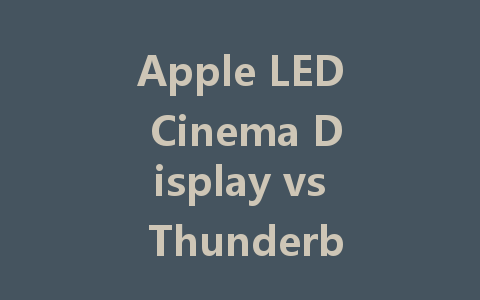
In the world of high-quality displays, Apple’s LED Cinema Display and Thunderbolt Display have made a significant mark. Each has its unique features and benefits, catering to different kinds of users. Whether you’re a professional designer, a video editor, or just someone looking to enhance their viewing experience, understanding the differences and advantages of these displays is crucial. In this article, we’ll examine both displays to help you decide which is the best fit for your needs.
Understanding the Displays
What is the Apple LED Cinema Display?
The Apple LED Cinema Display was launched to provide users with an expansive viewing experience, perfect for creative professionals. Featuring an impressive resolution and color accuracy, it was designed to work seamlessly with a range of Apple products. What sets the Cinema Display apart is its sleek design, high-quality IPS panel, and built-in FaceTime camera and speakers, all housed in a beautiful aluminum enclosure.
What is the Apple Thunderbolt Display?
The Apple Thunderbolt Display was introduced as a successor to the Cinema Display, bringing even greater versatility to the table. Besides a larger screen size, the Thunderbolt Display supports the Thunderbolt connection, allowing for faster data transfer speeds and daisy-chaining multiple devices. Like the Cinema Display, it also features an IPS panel for vibrant colors and wide viewing angles, along with integrated FaceTime HD camera and audio output.
Key Differences Between the Displays
Resolution and Screen Quality
Both displays boast a high-quality build, but there are differences in specifications that may sway your decision.
Connections and Compatibility
One of the most significant differences between these two displays is in their connectivity.
Size and Design
While both displays have a gorgeous aesthetic, the size can be a decisive factor.
Performance in Real-World Use
Color Accuracy and Brightness
For professionals in photography or video editing, color accuracy is crucial. Both displays deliver exceptional performance;
Usability and User Experience
Consider the overall user experience when deciding between the two:
Price Considerations
Price can play a significant role in your decision. Generally, the Thunderbolt Display tends to be priced higher due to its advanced features and specifications.
Conclusion: Which One Should You Choose?
Ultimately, the choice between the Apple LED Cinema Display and the Thunderbolt Display comes down to your specific needs and usage scenarios.
Whatever your choice, both displays represent Apple’s commitment to quality and user-friendly design, ensuring that you will be satisfied with your decision. Take the time to assess your needs and preferences, and you’ll find the display that perfectly complements your workflow.